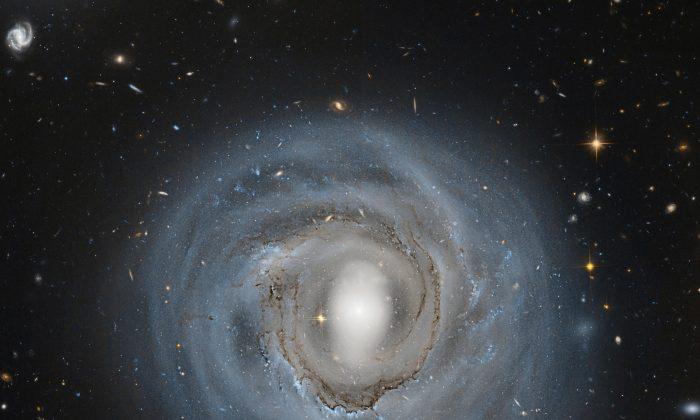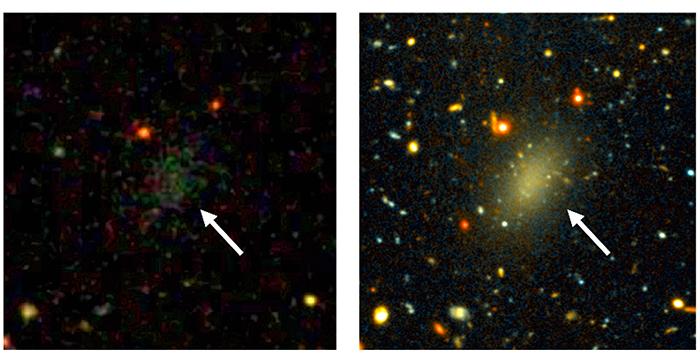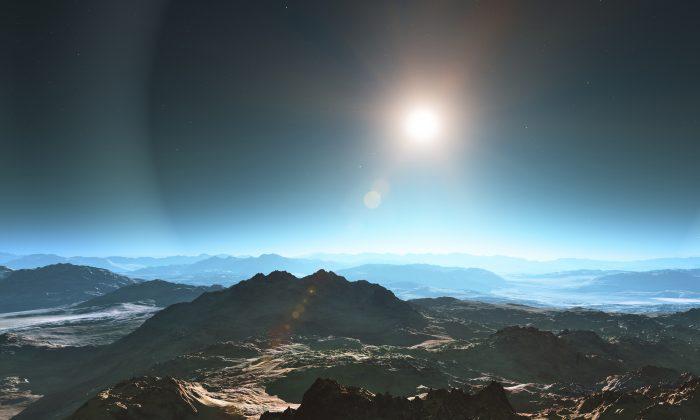Powerful cosmic winds can blow through galaxies, sweeping out interstellar material and stopping future star formation.
An analysis of one such event in a nearby galaxy provided an unprecedented look at the process and offered a clearer snapshot of how it works.
Astronomers looked at the way the cosmic wind erodes gas and dust at the leading edge of the galaxy. The wind, or ram pressure, is caused by the galaxy’s orbital motion through hot gas in the cluster.
Researchers discovered a series of intricate dust formations on the disk’s edge, as cosmic wind began to work its way through the galaxy.
Looks Like Taffy
“On the leading side of the galaxy, all the gas and dust appears to be piled up in one long ridge, or dust front,” says Jeffrey Kenney, an astronomer at Yale University.
“But you see remarkable, fine scale structure in the dust front. There are head-tail filaments protruding from the dust front. We think these are caused by dense gas clouds becoming separated from lower density gas.”
Cosmic wind can easily push low-density clouds of interstellar gas and dust, but not high-density clouds. As the wind blows, denser gas lumps start to separate from the surrounding lower density gas which gets blown downstream. But apparently, the high and low-density lumps are partially bound together, most likely by magnetic fields linking distant clouds of gas and dust.
“The evidence for this is that dust filaments in the HST (Hubble Space Telescope) image look like taffy being stretched out,” Kenney says. “We’re seeing this decoupling, clearly, for the first time.”
Destruction and Creation
The analysis, reported in the Astronomical Journal, is based on Hubble images of a spiral galaxy in the Coma cluster, located 300 million light years from Earth. It is the closest high-mass cluster to our solar system. Kenney first saw the images two years ago and realized their possible significance in understanding the way ram pressure strips interstellar material throughout the universe.
In the 1990s, a famous Hubble photo dubbed “Pillars of Creation” showed columns of dust and gas in the Eagle Nebula that were in the process of forging new stars. The dust filaments Kenney identified are similar in some ways to the “Pillars of Creation,” except they are 1,000 times larger.
In both cases, destruction is at least as important as creation. An external force is pushing away most of the gas and dust, therefore destroying most of the cloud, leaving behind only the most dense material—the pillars. But even the pillars don’t last that long.
Galaxy Evolution
Because gas is the raw material for star formation, its removal stops the creation of new stars and planets. In the Eagle Nebula, the pressure arises from intense radiation emitted by nearby massive stars; in the Coma galaxy, it is pressure from the galaxy’s orbital motion through hot gas in the cluster.
Although new stars are being born in both kinds of pillars, we’re witnessing in both the last generation of stars that will form.
Much of Kenney’s research has focused on the physical interplay of galaxies with their environment.
“A great deal of galaxy evolution is driven by interactions,” he says. “Galaxies are shaped by collisions and mergers, as well as this sweeping of their gas from cosmic winds. I’m interested in all of these processes.”
Other researchers from Yale and from the Universidad de Guanajuato in Mexico are coauthors of the study.
Source: Yale University. Republished from Futurity.org under Creative Commons License 4.0.





Friends Read Free